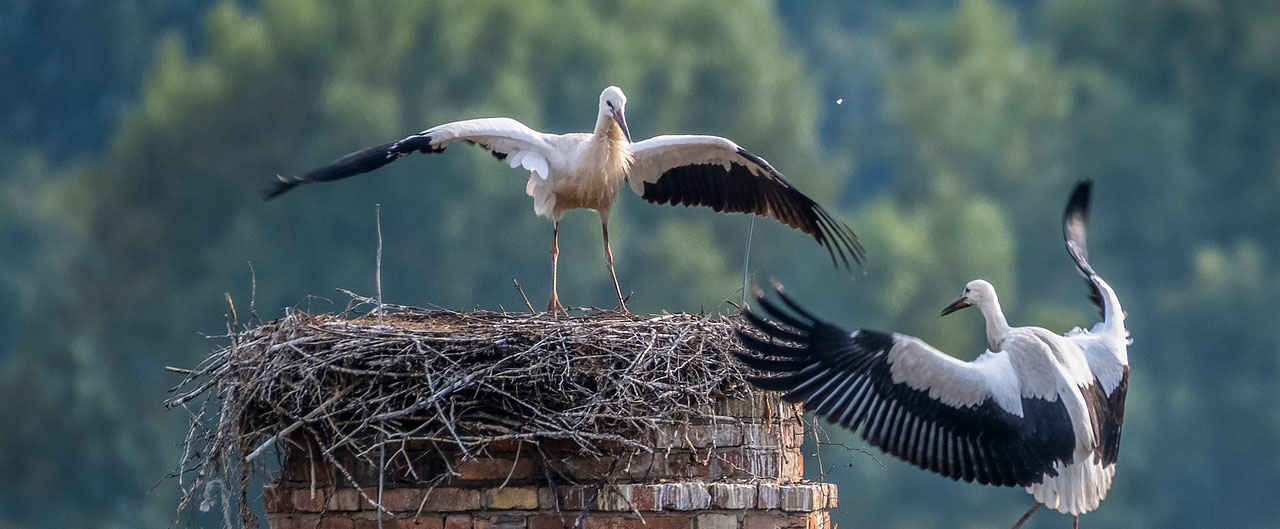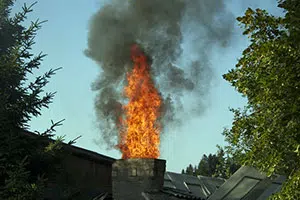Dead Bird in Chimney
Have you heard some scratching, fluttering, or even heard a cheep or chirp? And then, no more sounds... just silence? Or, are you noticing a foul smell coming from your wood stove or fireplace? Maybe you're noticing flies or other unpleasant creatures, like maggots? Chances are, you've had a bird with the misfortune of getting lost or stuck in your chimney and that poor bird is now deceased. This isn't as uncommon as you might think. Let's explore how this situation came about, what to do now, and how to prevent it from happening again.

Common Reasons for Bird Entry
It isn't an uncommon sight to see birds big or small rest and even nest on or near a chimney. While this may not be a problem - as long as the chimney isn't in use -, it does set the scene for one or more birds entering the chimney, voluntarily or by accident. Unfortunately, once having descended down the chimney, birds often become disoriented and will eventually succumb to exhaustion and/or dehydration. But why are they hanging around your chimney to begin with?
Nesting Sites
Chimneys are the perfect shelter for birds; way out of reach of ground predators, easily accessible, and with a spectacular view of surroundings. A room with a view, if you will., Common birds you'll find nesting on or even in chimneys include grackles, starlings, sparrows, swifts, and more. Did you know that there's a type of swift actually called "Chimney Swift"? This smokey-gray little bird spends most of its life in the air and does not, or cannot, perch like other birds. It hangs on the sides of - you guessed it - chimneys or trees with its particularly sharp claws. Large numbers of Chimney Swifts may nest in chimneys during the nonbreeding season.
Warmth
Chimneys - even when not in use - tend to retain daytime warmth and be considerably warmer than outdoor temperatures, particularly at night. So, in early spring or during falling temperatures in the fall, birds may simply seek refuge from the cold and elements in your chimney.
Exploration
Ah, yes - the adventurer. The explorer. No, all kidding aside, birds don't regularly go on excursions just for the thrill of adventure. Now, going down an unusual path in the search for food may be a more likely explanation. Chimneys can indeed be host to a number of bugs or insects and may warrant a special mission. Bugs who may frequent your chimeny include cluster flies, stink bugs, ladybugs, conifer seed bugs, and even wasps.
Safety
Well, all of the reasons above really add up to safety. Your chimney is a sheltered place, dark, quiet, out of wind and weather, and with a potential built-in food cart. What's not to love? Unfortunately, most bird species have trouble flying straight up - and that's when that safe chimney becomes a death trap.
What if there's a Live Bird in your Chimney?
If you suspect that a bird has gone too far down the proverbial rabbit hole (or chimney) and is stuck or just too disoriented to find its way out, you can try to turn off the lights in the house, open the flue, and open a door. The hope is that the bird will follow the light to the exit and make its way out. If you have a straight stove pipe, you can try to gently knock on and shake the pipe in hopes that the bird will actually fall through to your wood stove. You can then open the door and carefully remove or release the bird. Stand back, as there will be a considerable amount of ashes and dust coming out along with your little bird friend.
 Removal Process for a Dead Bird in Your Chimney
Removal Process for a Dead Bird in Your Chimney
When all hope is lost that our fine feathered friend will make an exit on its own, it's time to shift the operation from rescue to recovery. The bird likely dies from exhaustion during and after a series of attempts to escape. The stress, fatigue, and lack of water will take their toll on the bird and you are now faced with removing a dead bird.
DIY Removal Methods: Why They're Not Worth It
So, you're going to attempt this yourself. Before you start, you should have at least some minimal PPE at hand: gloves and an N95 mask are a must. Birds carry a host of bacteria and secondary pests, such as mites and ticks, and you since you have a carcass in your chimney, you are now dealing with maggots and fly larvae as well. Particular attention is warranted to any fecal matter left behind by birds; there is a real danger of contracting histoplasmosis when handling bird feces. Once the dead bird has been removed, it's time to clean up blood, feces, and other bodily fluids.
What to Do
Depending on where the dead bird is located, you can open the damper and search above the firebox to see if there's a bird inside the flue with a flashlight. You may be able to extract the bird from below. If this is not an option, you can try to remove the dead bird from the top. This will require you to get up on the rood with a chimney rod and hook. Once the bird has been retrieved, you will need to dispose of it. Triple bag the carcass and any feces, loose feathers, etc.
 What Not to Do
What Not to Do
Do NOT light a fire. While this may seem like a somewhat logical solution, the very last thing you'll want to experience it is a chimney fire that could potentially spread to the rest of your home. Practicing fireplace safety is of utmost importance.
When to Call a Professional: Why It's the Better Option
There is a good chance that you won't be able to remove the dead bird from above or below. A professional will have to cut into the side of your chimney to remove dead animals from your chimney. Aside from potential health concerns while extricating the dead bird, you'll still need to deal with clean up and disposal of blood and other bodily fluids. The smell of rotting flesh and staining of the inside of your chimney will need to be addressed. Again all of this needs to be done with great care and PPE. Handling dead wildlife is not safe for the average home owner.
How Hawkeye Can Help with Bird Removal and Prevention
Hawkeye Bird & Animal Control is a professional bird and wildlife removal service. Let us put over 30 years of experience and expertise with bird control, chimney bird removal, and exclusion to work for you. Our technicians are familiar with safety and removal protocols of wildlife in chimneys and are standing by to keep your chimney safe from birds or other wildlife. We will assess your particular situation and install what is needed to prevent a repeat occurrence. Contact us today and secure your chimney for the upcoming heating season.














